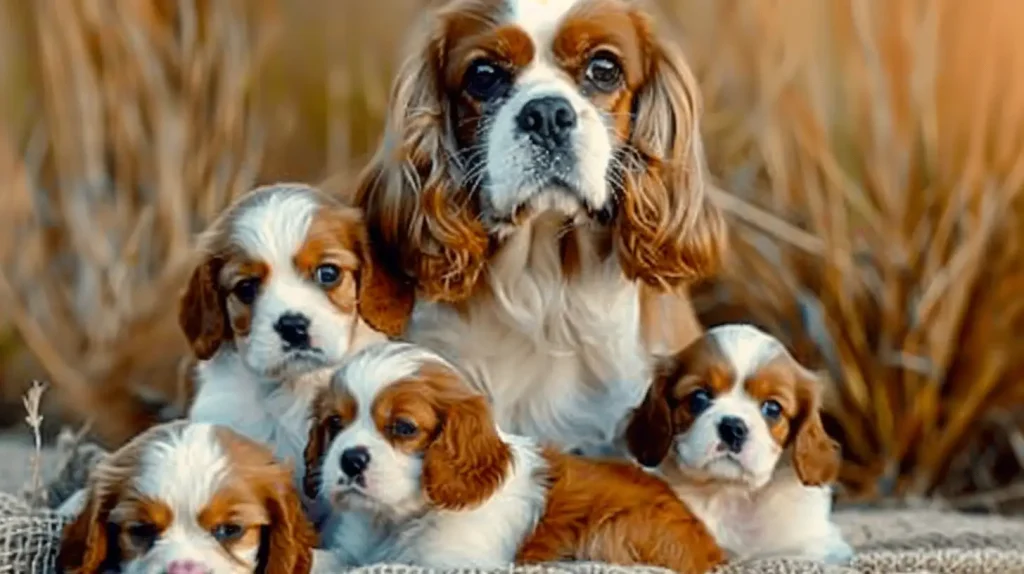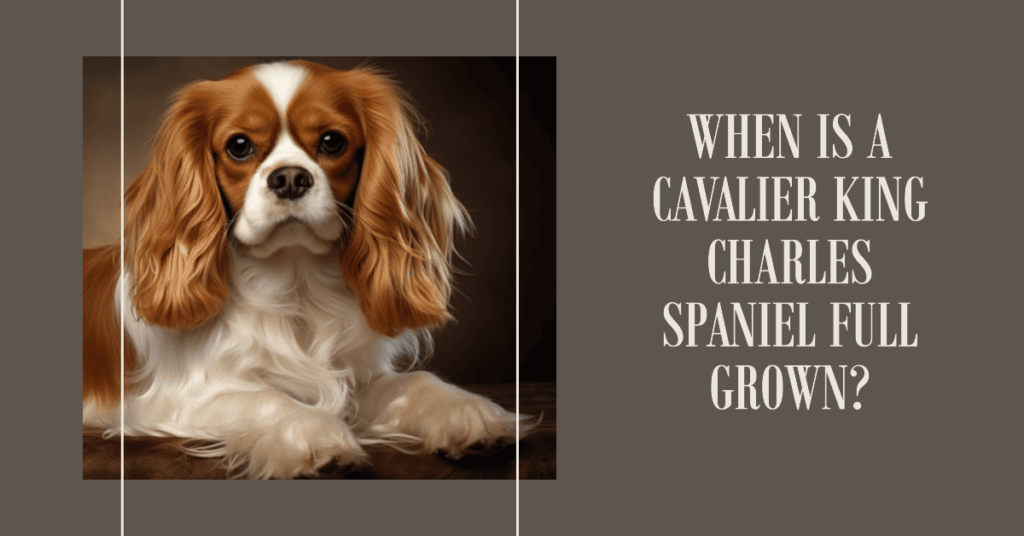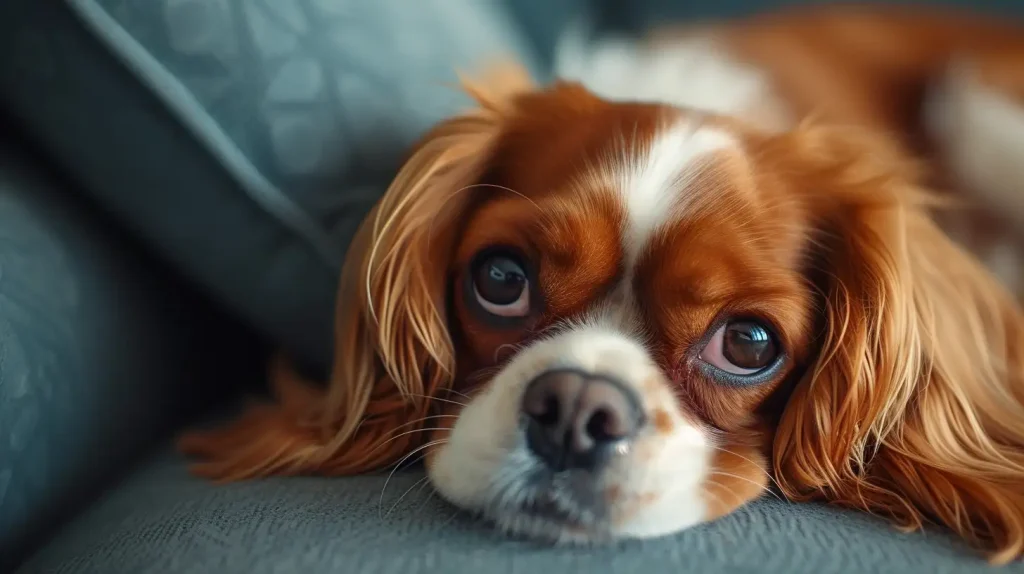Table of Contents
Are you wondering how many litters a Cavalier King Charles Spaniel can have in one year? Well, the exact number can depend on various factors including the health of the dog, breeding practices, and the interval between litters, as it is recommended to allow the female dog to rest between pregnancies to ensure her health and the health of the puppies.
We will discuss this topic further in the following paragraphs…
A Glimpse into Reproduction in Dogs
Diving into the realm of canine reproduction, let’s start by unravelling the mysteries of the estrous cycle. Comparable to a woman’s menstrual cycle, this series of hormonal changes dictates when a female dog can conceive. Significantly, unlike humans who can conceive at any time, dogs have distinct periods of fertility, often referred to as ‘being in heat’.
The cycle is divided into four stages: Proestrus, Estrus, Diestrus, and Anestrus. The Proestrus phase is when the female begins to attract males but is not yet receptive to mating. This stage usually lasts around nine days.
Following this, the Estrus phase begins, where the female dog will accept a male and can conceive. This phase lasts roughly nine days as well but can range from 3 to 21 days. During this time, a successful mating can result in a litter of puppies approximately 63 days later.
Afterward, the dog enters the Diestrus phase. Regardless of whether the mating was successful, hormonal changes will make her body behave as if she is pregnant. This stage typically lasts about two months.
Finally, the Anestrus stage represents a resting phase. The dog’s body recuperates, and the whole cycle starts anew. This phase can last anywhere from two to three months, leading to most female dogs having two heat cycles per year.
Cavalier King Charles Spaniels typically experience their first heat between six to twelve months of age, signaling the onset of reproductive maturity. However, as with humans, reaching sexual maturity doesn’t mean they’ve achieved optimal adult development. Physical and emotional maturity, where they’re at their prime, is typically reached around the age of three. Until then, they continue to grow, adapt, and evolve, both in body and character.
Factors Influencing Litter Frequency in Cavalier King Charles Spaniels
When we step into the world of Cavalier breeding, the unique personality and individuality of each Spaniel becomes an essential element of consideration. The frequency with which these adorable canines can produce litters is dependent on various factors, each as important as the next.
| Factor | Description | Impact on Litter Frequency |
|---|---|---|
| Age of Female | Optimal breeding age is between 2 and 5 years. Breeding before or after this range can pose health risks to the mother and the pups. | Decreases frequency outside optimal age range. |
| Health Status | Requires clearance for genetic conditions (e.g., heart issues, hip dysplasia). Healthy females are more likely to have regular, healthy litters. | Poor health can significantly reduce frequency. |
| Breed Standards and Regulations | Breed clubs and kennel clubs may have guidelines or limitations on breeding frequency to encourage responsible breeding practices. | May limit frequency to ensure health and welfare. |
| Reproductive Health | Factors such as fertility and the ability to carry a pregnancy to term. Regular veterinary check-ups are essential. | Complications can decrease frequency. |
| Rest Periods | Adequate rest between litters is crucial for the health of the female. Overbreeding can lead to significant health issues. | Required rest periods limit frequency. |
| Breeder Practices | Ethical breeders will prioritize the health of the female and the quality of life for the puppies over the number of litters produced. | Ethical practices may reduce frequency. |
| Nutrition and Care | Proper nutrition and care before, during, and after pregnancy can impact reproductive health and litter frequency. | Poor care can reduce litter frequency and health. |
This table serves to highlight that responsible breeding practices are essential for maintaining the health and welfare of Cavalier King Charles Spaniels. Each factor plays a significant role in determining the appropriate and ethical frequency of litters for each individual female within the breed.
Natural Fertility Rate
The natural fertility rate for Cavaliers is influenced by their size. Given their petite stature, Cavaliers tend to produce smaller litters compared to larger breeds. A typical litter for this breed can range from two to six puppies. Of course, there’s always room for outliers, with some litters being smaller or larger. The fertility rate also tends to decrease with age, with younger, healthy Cavaliers often producing more robust litters.
Health Considerations
The health of a Spaniel plays a pivotal role in her ability to conceive and successfully bear a litter. A well-cared-for, healthy Spaniel, enjoying a balanced diet, regular exercise, and up-to-date veterinary care, is generally more likely to conceive and deliver a healthy litter than a dog facing health challenges. It’s important to note, however, that even the healthiest of dogs should not be overbred. They deserve ample time to rest and recuperate between litters.
Age Influence
Age is another influential factor. While it’s true that our furry pals can technically breed after their first heat, it’s not necessarily the optimal choice. In the best interests of both the mother and her future puppies, responsible breeders often wait until the dogs have reached full maturity, both physically and emotionally. This usually occurs around the age of three. It ensures the mother is ready to handle the demands of pregnancy, birth, and puppy rearing.
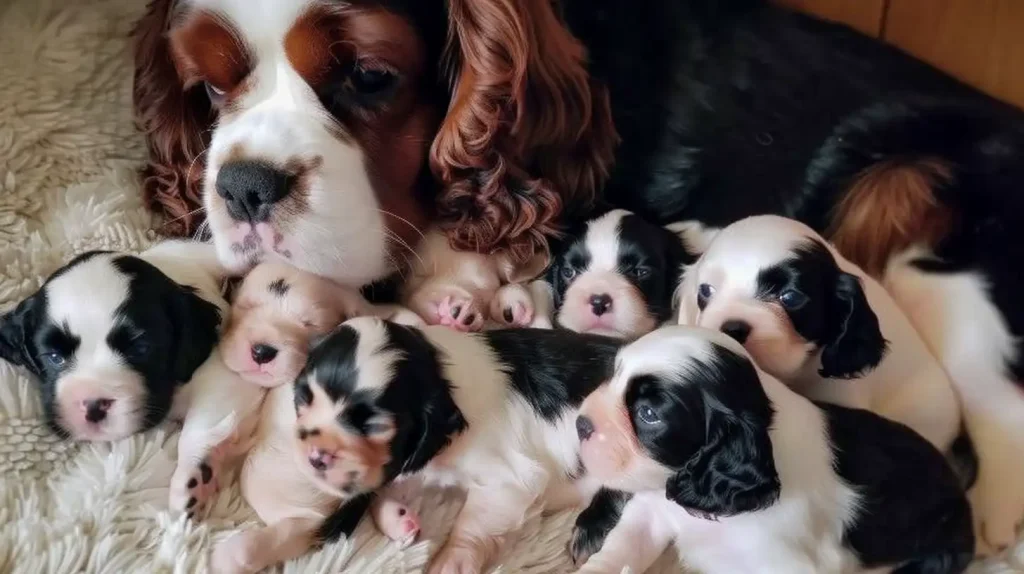
The Ideal Number of Litters: A Deep Dive
When it comes to breeding, a common query often arises: “What is the optimal number of litters per year for our Cavaliers?” While straightforward on the surface, the question warrants a deeper dive.
Theoretically, given the natural estrous cycle, a healthy Cavalier can have two litters per year. However, is this ideal? One litter per year is generally considered a safe benchmark. It gives the mother ample time to recover from the demands of pregnancy and lactation before embarking on the journey again.
Balancing Act
Breeding Cavaliers is a delicate balancing act between preservation of the breed and ensuring the wellbeing of the mother. Back-to-back litters can put a strain on the dog’s body, potentially leading to health complications. It’s akin to running a marathon without a breather. Every marathoner, human or canine, needs time to rest and rejuvenate.
Moreover, pregnancy and puppy rearing are demanding both physically and emotionally. From the moment the puppies are born until they leave for their new homes, the mother invests heavily in nurturing, feeding, and teaching them. This ‘job’ requires significant energy and can be exhausting.
Guidance from Experience
Heeding the voice of experience, many seasoned breeders advocate for at least a year’s rest between litters. This rest period allows the mother to regain her strength, ensuring she is in optimal health before she embarks on the next pregnancy. The health and happiness of the mother directly influences the health of her puppies. A well-rested, healthy mother is more likely to have a smooth pregnancy and give birth to robust, healthy puppies.
Responsible Breeding Practices
In the sphere of breeding, there’s a mantra that echoes loud and clear – responsibility. The value of responsible breeding cannot be overemphasized. It is the cornerstone that underpins the very future of our cherished Cavaliers.
Breeding isn’t a numbers game. It’s not solely about increasing the ranks of this delightful breed. Rather, it’s an intricate tapestry of decision-making and practices that have the potential to shape the health, vitality, and future of the entire breed. Each choice, every action, has a ripple effect that extends far beyond the immediate litter.
The Breeder’s Role
As a custodian of this beloved breed, your role is undeniably crucial. You wield the power to mold the future of Cavaliers, both at a micro level – within your own home – and at a macro level – influencing the larger breed population.
Every breeding decision should be steeped in careful consideration and research. Knowing the health history of your Cavaliers, understanding their personalities, and acknowledging their unique quirks are all part of this puzzle. Your actions can help prevent the propagation of health issues and contribute to the genetic diversity and strength of the breed.
The Ethos of Responsibility
But what does responsible breeding look like? It encompasses practices such as health testing for genetic conditions, considering the physical and emotional wellbeing of the mother before, during, and after pregnancy, ensuring the puppies are well-socialized, and finding responsible, loving homes for each one.
Furthermore, responsible breeding means knowing when to retire a breeding dog and provide her with a well-earned rest. It’s about understanding that every Cavalier is not just a breeding dog, but a companion who deserves love, care, and a fulfilling life.
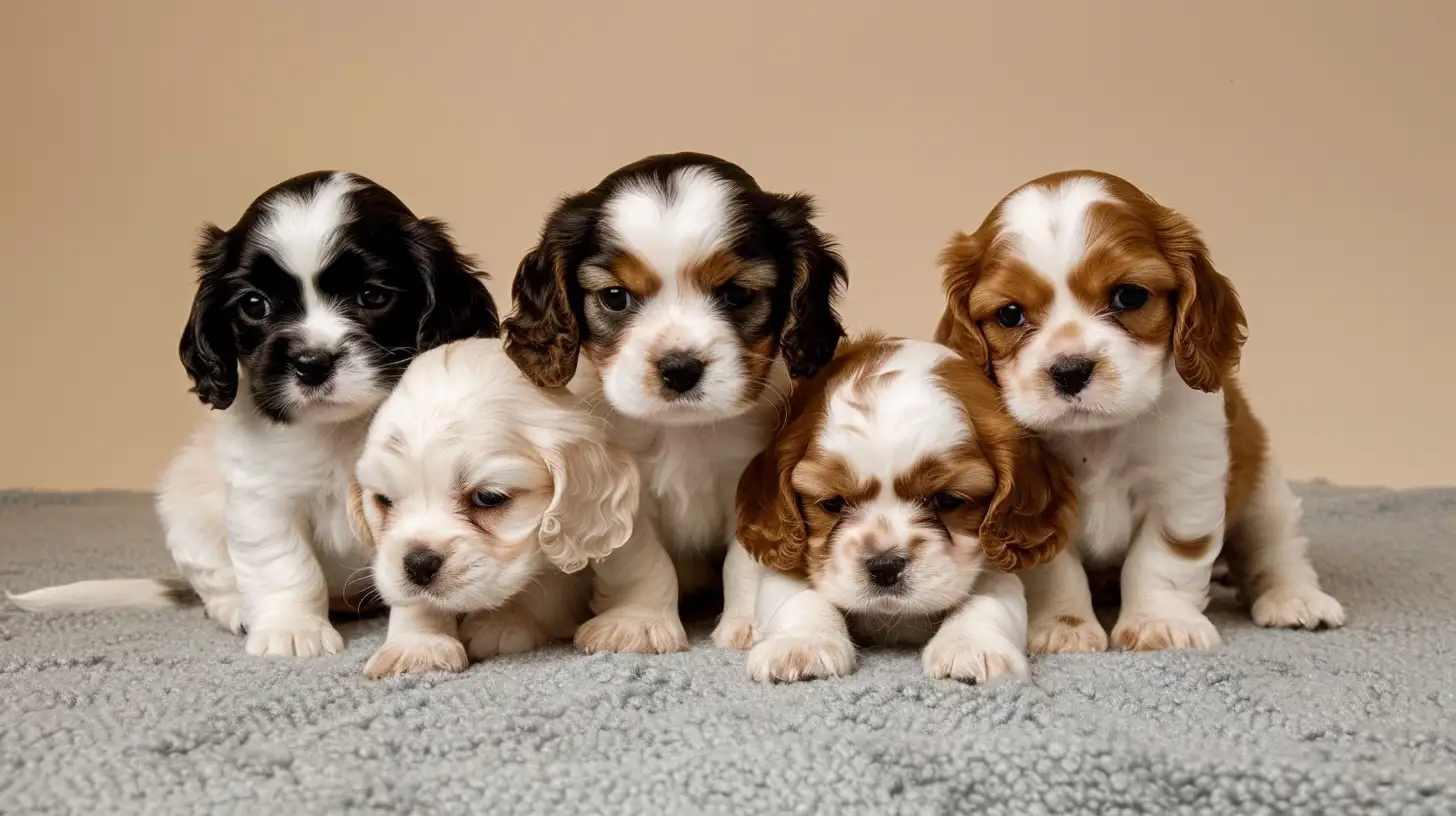
Special Considerations for Cavalier King Charles Spaniels
Our Cavaliers, as enchanting as they are, carry with them certain susceptibilities. In the Cavalier’s genetic hand of cards, conditions like mitral valve disease (MVD) and syringomyelia (SM) are unfortunately common. These health issues have far-reaching impacts, influencing not only the dogs’ general quality of life but also their ability to safely bear litters.
Mitral Valve Disease (MVD)
MVD is a heart condition where the mitral valve weakens, leading to a backflow of blood into the left atrium. Cavaliers are particularly prone to this condition, with many developing it at a relatively young age compared to other breeds. A Cavalier suffering from MVD may be less resilient to the physical demands of pregnancy and nursing, which can potentially compromise her health and that of her puppies.
Syringomyelia (SM)
SM, on the other hand, is a neurological disorder that can lead to severe discomfort and physical impairments. This condition, characterized by the formation of fluid-filled cavities in the spinal cord, can reduce a Cavalier’s ability to handle pregnancy, birth, and motherhood. Moreover, it’s a hereditary condition, implying that an affected Cavalier could potentially pass it on to her offspring.
In light of these breed-specific considerations, breeding Cavaliers transforms into an intricate dance, a careful balance of passion for the breed and the sobering realities of genetic science. It demands informed, conscious decision-making, always prioritizing the health and wellbeing of the dogs involved.
The Role of a Veterinarian
In this delicate balancing act, your veterinarian is an indispensable ally. Always consult with them before making any breeding decisions. They can provide guidance based on comprehensive health examinations, genetic testing, and their understanding of the breed. Their insights can help you make choices that uphold the health of your Cavaliers and contribute positively to the breed’s future.
Conclusion: How Many Litters Can a Cavalier King Charles Spaniel Have in a Year?
There’s a lot to unpack when considering how many litters a Cavalier King Charles Spaniel can have in a year. We’ve navigated the terrain of dog reproductive cycles, delved into breed-specific fertility considerations, and emphasized responsible breeding. Let’s keep the conversation going, promoting responsible and compassionate practices that ensure our Cavaliers thrive. After all, isn’t the love for this wonderful breed why we’re all here?
COPYRIGHT NOTICE
Please be advised that all images, designs, and creative content on this page are the exclusive property of Spanielhub.com and are protected under international copyright laws. The images may not be reproduced, copied, transmitted or manipulated without the written permission of Spanielhub.com.
Unauthorized use, distribution, display, or creation of derivative works of any images contained on this page, is strictly prohibited and can lead to legal penalties. We actively monitor for, and enforce, our copyright interests.
If you wish to use any of our images, kindly contact us to seek permission. Respect of copyright is not merely a legal requirement but also an acknowledgement and support of the hard work and creativity that goes into producing them.
Thank you for your understanding and cooperation.
© 2023, Spanielhub.com. All Rights Reserved.
Last update on 2024-04-15 / Affiliate links / Images from Amazon Product Advertising API

